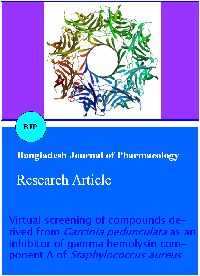Virtual screening of compounds derived from Garcinia pedunculata as an inhibitor of gamma hemolysin component A of Staphylococcus aureus
DOI:
https://doi.org/10.3329/bjp.v9i1.17368Keywords:
Garcinia, Garcinia pedunculata, Staphylococcus aureus, 1, 3, 6, 7-tetrahydroxyxanthone, Garcinone D, virtual screening, dockingAbstract
With the emergence of multi-drug resistant pathogens at alarming frequency, there has been an increase interest in the development of novel drugs from natural resources. The use of higher plants and preparations made from them to treat infections is a longstanding practice in a large part of the population, especially in the developing countries, where there is dependence on traditional medicine for a variety of ailments. The virtual screening method was used in this study to analyze the docking and inhibitory activities of some natural bioactive compounds present within Garcinia pedunculata against hemolysin toxin of Staphylococcus aureus, gamma-hemolysin component A hlgA. The study resulted in identifying compounds 1,3,6,7-tetrahydroxyxanthone and garcinone D with high binding affinity towards the target protein revealing them as potent inhibitors that could be further used to create new drug source in the treatment of staphyloccocal infections.
Downloads
1499
868 Read
243
References
Church D, Elsayed S, Reid O, Winston B, Lindsay R. Burn Wound Infections. Clin Microbiol Rev. 2006; 19: 403-34.
Clyne M, De Azavedo J, Carlson E, Arbutnott J. Production of gamma-hemolysin and lack of production of alpha-hemolysin by Staphylococcus aureus strains associated with toxic shock syndrome. J Clin Microbiol. 1988; 26: 535-39.
David MZ, Boyle-Vavra S, Zychowski DL, Daum RS. Methicillin-susceptible Staphylococcus aureus as a predominantly healthcare-associated pathogen: A possible reversal of roles. PLoS ONE. 2011; 6: e18217.
David MZ, Daum RS. Community-associated methicillin-resistant Staphylococcus aureus: Epidemiology and clinical consequences of an emerging epidemic. Clin Microbiol Rev. 2010; 23: 616-87.
DeLeo FR, Otto M, Kreiswirth BN, Chambers HF. Community-associated meticillin-resistant Staphylococcus aureus. Lancet 2010; 375: 1557–68.
Ferreras M, Höper F, Dalla Serra M, Colin DA, Prévost G, Menestrina G. The interaction of Staphylococcus aureus bi-component gamma-hemolysins and leucocidins with cells and lipid membranes. Biochim Biophys Acta. 1998; 11; 1414: 108-26.
Langer T, Wolber T. Virtual combinatorial chemistry and in silico screening: Efficient tools for lead structure discovery. Pure Appl Chem. 2004; 76: 991-96.
Laurie AT, Jackson RM. Q-SiteFinder: An energy-based method for the prediction of protein-ligand binding sites. Bioinformatics 2005; 21: 1908-16.
Lii JH, Gallion S, Bender C, Wikstrom H, Allinger NL, Flurchick KM, Teeter MM. Molecular mechanics (MM2) calculations on peptides and on the protein crambin using the Cyber 205. J Comp Chem. 1989; 10: 503-13.
Lipinski CA, Lombardo F, Dominy BW, Feeney PJ. Experi-mental and computational approaches to estimate solubility and permeability in drug discovery and development settings. Adv Drug Delivery Rev. 2001; 46: 3-26.
Marvin JA, Heck EL, Loebl EC, Curreri EL, Baxter CR. Usefulness of blood cultures in confirming septic complications in burn patients: Evaluation of a new culture method. J Trauma 1975; 15: 657-62.
Meunier O, Ferreras M, Supersac G, Hoeper F, Baba-Moussa L, Monteil H, Colin DA, Menestrina G, Prévost G. A predicted beta-sheet from class S components of staphylococcal gamma-hemolysin is essential for the secondary interaction of the class F component. Biochim Biophys Acta. 1997; 12: 1326: 275-86.
Ozawa T, Kaneko J, Kamio Y. Essential binding of LukF of staphylococcal gamma-hemolysin followed by the binding of H gamma II for the hemolysis of human erythrocytes. Biosci Biotechnol Biochem. 1995; 59: 1181-83.
Pettersen EF, Goddard TD, Huang CC, Couch GS, Greenblatt DM, Meng EC, Ferrin TE. UCSF Chimera: A visualization system for exploratory research and analysis. J Comput Chem. 2004; 25: 1605-12.
Roblin P, Guillet V, Joubert O, Keller D, Erard M, Maveyraud L, Prevost G, Mourey L. A covalent S-F heterodimer of leucotoxin reveals molecular plasticity of beta-barrel pore-forming toxins. Proteins 2008; 71: 485-96.
Menestrina G, Dalla Serra M, Coraiola M, Viero G, Comai M, Potrich C, Ferreras M, Baba-Moussa L, Colin DA, Bhakdi S, Prévost G. Staphylococcus aureus bicomponent gamma-hemolysins, HlgA, HlgB, and HlgC can form mixed pores containing all components. J Chem Inf Model. 2005; 45: 1539-45.
Sahu A, Das B, Chatterjee A. Polyisoprenylated benzophenones from Garcinia pedunculata. Phytochemistry 1989; 28: 1233-35.

Published
How to Cite
Issue
Section
License
Authors who publish with this journal agree to the following terms:
- Authors retain copyright and grant the journal right of first publication with the work simultaneously licensed under a Creative Commons Attribution License that allows others to share the work with an acknowledgement of the work's authorship and initial publication in this journal.
- Authors are able to enter into separate, additional contractual arrangements for the non-exclusive distribution of the journal's published version of the work (e.g., post it to an institutional repository or publish it in a book), with an acknowledgement of its initial publication in this journal.
- Authors are permitted and encouraged to post their work online (e.g., in institutional repositories or on their website) prior to and during the submission process, as it can lead to productive exchanges, as well as earlier and greater citation of published work (See The Effect of Open Access).
